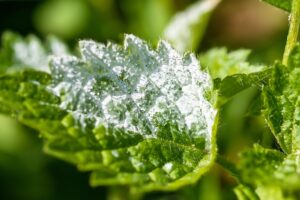Understanding Powdery Mildew
Learn how to get rid of powdery mildew. Powdery mildew is a fungal disease that targets a wide range of plants, appearing as a distinctive white or gray powdery deposit on the leaf surface, stem, and sometimes fruit. The fungus thrives in warm, dry environments with high humidity, and can spread rapidly if not managed effectively.
Identifying the signs of infection:
- White or Gray Powdery Spots: The most obvious sign is the appearance of white or grayish powdery spots on the leaves and stems.
- Distorted Leaves: As the infection progresses, leaves may become twisted or distorted.
- Yellowing Leaves: You might notice the leaves turning yellow or brown, and eventually, they could dry out and fall off.
- Reduced Vigor: The overall vigor of the plant may decline, and it could appear stunted or stressed.
Preventative Measures
Proper Plant Spacing to Improve Air Circulation:
One critical preventative measure against powdery mildew is ensuring proper plant spacing. Adequate distances between plants will improve air circulation, which helps to lower humidity around the foliage and stems. This environment makes it less conducive for the powdery mildew spores to settle and germinate. Furthermore, good air circulation allows for quicker drying of leaves, reducing the chances of the fungus establishing itself after watering or rain. In essence, thoughtful spacing is not only beneficial for plant growth but is also a strategic defense against the spread of fungal diseases.
Choosing Resistant Varieties:
In the fight against powdery mildew, selecting plant varieties that are resistant to the disease is a forward-thinking approach. Many cultivars have been specifically bred to be less susceptible to fungal infections, including powdery mildew. Incorporating these resistant varieties into your garden can reduce the need for chemical fungicides and can be an integral part of an integrated pest management strategy. When choosing plants, look for those labeled as ‘mildew-resistant’ or consult with local nurseries regarding the best options for your area. This proactive measure empowers gardeners to maintain healthy, vibrant plants with a robust line of defense against common pathogens.
Appropriate Watering Techniques:
Effective watering practices are essential in preventing powdery mildew. It is advisable to water plants early in the morning, giving the foliage and the soil surface ample time to dry before nightfall. Utilizing soaker hoses or drip irrigation can deliver water directly to the roots, minimizing moisture on leaves and stems which is crucial in preventing fungal growth. Additionally, using a mulch layer can help to reduce soil splash and retain moisture at the plant’s base, further decreasing the likelihood of powdery mildew development. Always be mindful of overwatering, as excessively damp soil can contribute to the proliferation of mildew and other fungal diseases.
Cultural Practices
Maintaining good cultural practices plays a pivotal role in the control of powdery mildew and other plant diseases. Among these, regular pruning stands out as a critical task. Pruning allows for increased air circulation within the foliage, which reduces humidity and the conditions favorable for fungal growth. Removing infected leaves and stems not only helps to prevent the spread of disease but also encourages the growth of healthy, robust plant structures. Gardeners should disinfect their pruning tools before and after use to prevent transmitting the pathogen from one plant to another. Regular inspection and timely pruning of affected areas can keep your garden looking its best while mitigating the risks associated with powdery mildew and promoting overall plant health.
Disinfecting Gardening Tools
Keeping gardening tools clean is crucial in the fight against powdery mildew and other plant pathogens. Tools used for pruning should be disinfected before moving on to another plant, especially if they were used to cut away infected plant material. A simple and effective method is to wipe the blades with a solution of one part bleach to nine parts water, or alternatively, use rubbing alcohol or a commercial disinfectant specifically designed for gardening tools. It’s important to properly dry the tools after disinfection to prevent rusting. This practice not only extends the life of your gardening implements but also ensures that they are not a vector for disease in your garden.
Removing and Disposing of Affected Leaves
When dealing with powdery mildew or other foliar diseases, prompt removal of affected leaves is a key strategy in preventing the spread. Leaves that exhibit the characteristic white, powdery spots should be carefully cut from the plant, ensuring not to shake the spores onto other parts of the plant or soil. Once these leaves are removed, it’s essential to dispose of them properly – they should never be added to your compost heap, as this could allow the disease to remain viable and spread. Infected plant matter should be sealed in a plastic bag and disposed of with household waste or through a municipal yard waste program that processes at high temperatures, capable of killing off any lingering pathogens.
Organic Remedies for Powdery Mildew
Organic Fungicidal Sprays
Organic fungicidal sprays are an effective measure in the holistic management of powdery mildew. These natural preparations often contain sulfur, neem oil, or baking soda, which inhibit the growth and spread of fungal diseases without the harsh impact on the environment often associated with synthetic chemicals. When applying fungicides, timing and coverage are critical; they should be applied early in the infection stage and thoroughly cover the susceptible parts of the plant. Regular application as per the manufacturer’s instructions can provide a protective barrier that helps to keep mildew at bay. Remember, while organic options are gentler, it’s still crucial to follow all safety guidelines to protect yourself and your plants.
Homemade Solutions
Using everyday household ingredients to create fungicidal solutions can be an accessible and cost-effective method for gardeners combatting powdery mildew. A popular homemade spray involves mixing baking soda with water and a small amount of liquid soap, which helps the mixture adhere to plant leaves. The alkaline nature of baking soda creates an inhospitable environment for the mildew to thrive. A typical recipe is one tablespoon of baking soda and a half teaspoon of liquid soap mixed into a gallon of water. This should be applied judiciously to affected areas, keeping in mind that overuse or applying under strong sunlight can cause leaf burn.
Horticultural Oils for Powdery Mildew
Horticultural oils present another natural option to combat powdery mildew by suffocating the spores. These lightweight oils, when sprayed directly onto affected plant surfaces, act by creating a thin film that inhibits the respiration of mildew spores. It is essential to apply these oils during cooler parts of the day to minimize the risk of leaf burn and to ensure thorough coverage for the best results. Being proactive with the application of horticultural oils can prevent the mildew from taking hold, and when used as part of an integrated pest management strategy, they are a valuable tool for maintaining plant health.
Chemical Solutions for Powdery Mildew
While natural solutions are preferable for their environmental friendliness and safety, the use of chemical fungicides becomes a consideration when dealing with severe or persistent powdery mildew outbreaks. Chemical options often offer a broader spectrum of control and can be more effective in halting the progression of the disease. They should be employed when natural remedies have failed to curb the spread of mildew, or when the potential loss of the crop or ornamental plant is significant. It is imperative to choose the appropriate fungicide for the specific type of plant and to follow the manufacturer’s instructions for application and safety to ensure the treatment’s efficacy and minimize any adverse effects on both the plants and the environment.
Selecting the Right Treatment Product
When deciding on a treatment for powdery mildew, it’s essential to consider the type of plant affected and the severity of the infection. Natural options like horticultural oils are ideal for mild cases and for use on plants that may be sensitive to harsher chemicals. For more aggressive infections, or when a valuable crop is at risk, a chemical fungicide might be necessary. Always select a product that specifically lists compatibility with the plant species you are treating, and opt for the least toxic option that will offer effective control. Before applying any product, thoroughly read and adhere to the manufacturer’s guidelines to protect your plants and the environment. Proactive monitoring and treatment can ensure the long-term health and vitality of your garden.
Safety Measures and Application Guidelines
Adhering to safety protocols when applying fungicides is critical to protect not only your plants but also yourself and the ecosystem. Personal protective equipment (PPE) such as gloves, safety goggles, and masks should be worn to avoid chemical exposure. It’s important to apply chemicals in calm weather conditions to prevent drift to unintended areas, and to always follow the specified dosage and application frequency to avert development of chemical resistance in pathogens. Moreover, consider the timing of applications to prevent adverse impacts on beneficial insects and pollinators. Proper storage and disposal of fungicides are equally important; keep them in their original containers, securely closed and out of reach of children and pets, and never pour unused chemicals into drainage systems. Always follow local regulations for the disposal of garden chemicals to ensure environmental safety.
Conclusion
In conclusion, understanding the role of fungicides in managing plant diseases is crucial for maintaining a healthy and productive garden. By implementing integrated pest management strategies, regularly monitoring plants, and following safety measures and application guidelines, you can effectively control fungal infections while minimizing harm to the environment. Remember to always prioritize using less toxic options and consult with a professional if necessary. With proper care, your garden will thrive and continue to bring you joy for years to come. Happy gardening! So, it is important to prioritize the long-term health and vitality of your garden by using safe and responsible practices when applying fungicides. By following these guidelines, you can protect both your plants and the environment while effectively managing plant diseases. Remember to always prioritize using less toxic options


